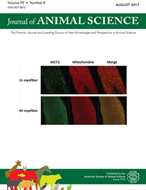-
Views
-
Cite
Cite
G. Su, M. S. Lund, D. Sorensen, Selection for litter size at day five to improve litter size at weaning and piglet survival rate, Journal of Animal Science, Volume 85, Issue 6, June 2007, Pages 1385–1392, https://doi.org/10.2527/jas.2006-631
Close - Share Icon Share
Abstract
Selection for total number of piglets born (TNB) since 1992 has led to a significant increase in this trait in Danish Landrace and Danish Yorkshire but has also been accompanied by an increase in piglet mortality. The objective of this study was to estimate the genetic and phenotypic parameters for litter size and survival to find alternative selection criteria to improve litter size at weaning. Data from Landrace (9,300 litters) and Yorkshire (6,861 litters) were analyzed using REML based on a linear model including genetic effects of sow and service-sire. The estimates of heritability (based on the sow component) for TNB, number born alive (NBA), and number alive at d 5 after birth (N5D) and at weaning (about 3 wk, N3W) ranged from 0.066 to 0.090 in Landrace and 0.050 to 0.070 in Yorkshire. Genetic correlations between TNB and N3W were 0.289 in Landrace and 0.561 in Yorkshire, but between N5D and N3W the estimated genetic correlation was 0.995 in both populations. The approximate estimates of heritability for survival rate per litter at birth (SVB = NBA/TNB), from birth to d 5 (SV5 = N5D/NBA), and from d 5 to weaning (SVW = N3W/N5D) were 0.130, 0.131, and 0.023, respectively, in Landrace, and 0.095, 0.043, and 0.009, respectively, in Yorkshire. Genetic correlations between TNB and survival rates at different stages were negative. On the other hand, genetic correlations between N5D and survival rates and between N3W and survival rates were strongly or moderately positive, except for the correlations with SVW in Yorkshire. The results suggest that selection for N5D could be an interesting alternative to improve litter size at weaning and piglet survival for Danish Landrace and Danish Yorkshire.





